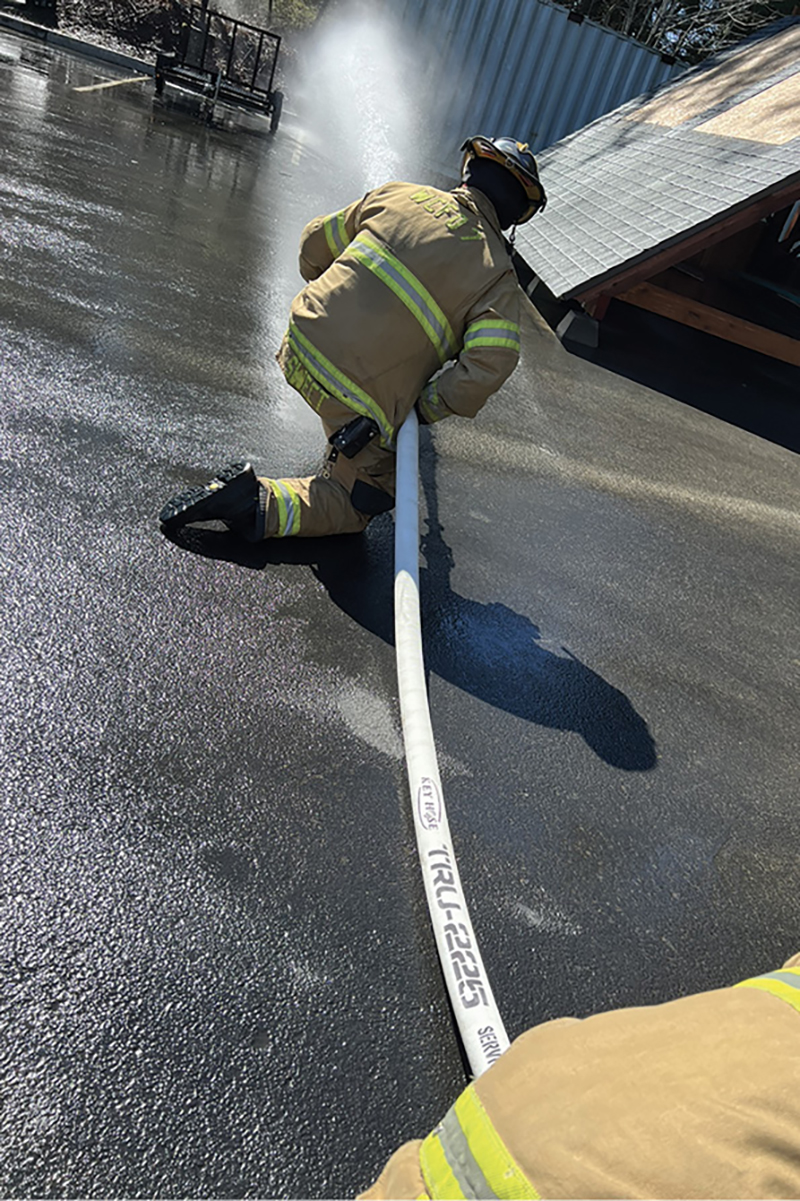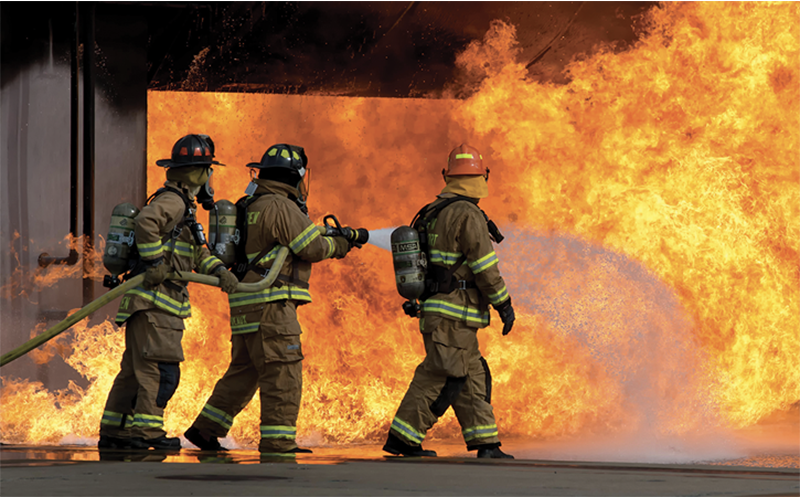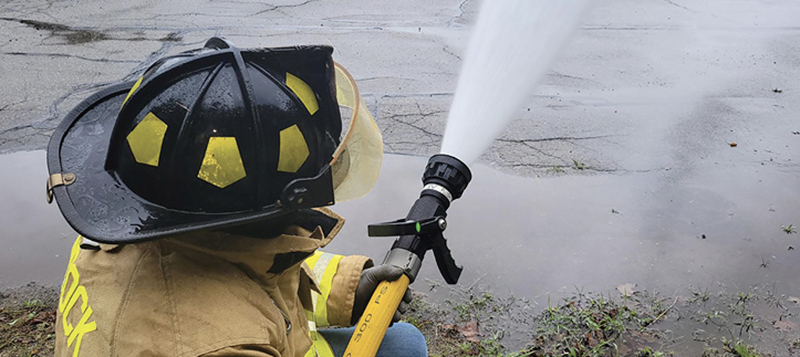From 1-inch forestry hose to 5-inch large-diameter hose (LDH), hose manufacturers continue to develop new versions and improve existing models.
While fire hose hasn’t changed a lot over the years, the materials that hose makers use to craft their products have improved the characteristics of hose, including dealing with friction loss, abrasion and cut resistance, and weight.
Dan Comer, vice president of sales and marketing for Snap-Tite Hose, says Snap-Tite’s newest attack hose is the Warrior. “The National Fire Protection Association (NFPA) wants hose to meet certain conductive and radiant heat requirements, so we came out with Warrior, made with a 100% para-aramid fiber outer jacket that’s basically Kevlar® coated, with an inner liner of proprietary nitrile rubber through the weave,” he points out. “In fire department testing, Warrior has been dragged through plate glass windows, shards of glass, nails, and had girders fall on it, but you can’t kill it,” Comer says. “And, we also have made Warrior meet packability and kink resistance standards and stand up to friction loss requirements.” He adds that Warrior is available in 1¾-inch and 2½-inch sizes.
Comer says that Snap-Tite’s UTX LDH uses a rugged polyester jacket that’s reinforced with an advanced polyurethane extruded through the weave to minimize friction loss and deliver greater flow. “UTX is available in 4-inch and 5-inch LDH; weighs 20% less than conventional rubber supply hose; remains flexible to –50°F; won’t mold or rot; is kink-resistant and snagproof; and resists ozone, oxidation, and most chemical and petroleum products,” he notes.
- Proper Hose Care and Maintenance: Why Does It Matter?
- Developments in Fire Hose, from Small to Large Diameter
- Hose Testing-Keeping It Safe
- Hose Storage and Care Solutions for Fire Stations
Mark Lighthill, vice president of sales at Key Hose, says the company’s latest hose development is its TRU-ID products that give a true internal diameter (ID) of 1¾ inches, 2¼ inches, and 2½ inches. “Our manufacturing standards allow TRU-ID to be more ergonomic, lighter in weight, and higher in quality double-jacketed fire hose,” Lighthill says. “We reduced overall hose weight by eliminating additional water found in oversized attack lines, thus reducing firefighter fatigue. These handlines are designed for use with low-pressure/high-volume nozzles.”
Joey Hayes, Key Hose account manager, says that Key Hose also makes Combat Sniper hose with a true internal diameter of 1.78 inches, designed for use with low-pressure/high-volume nozzles built to reduce hose whip and optimize friction loss. “Combat Sniper uses a double-jacketed, extruded through-the-weave nitrile/PVC tube construction that’s engineered to deliver targeted flows and have outstanding kink resistance and increased handling.”
Darren Corley, general manager of North American Fire Hose, says his company has most recently focused on attack hoselines that are made to handle low-pressure nozzles. “We make the Dura-Built™ hoseline that accomplishes that task,” Corley says, “and it’s available in sizes of 1½, 1¾, 2, 2½, and 3 inches and 4-inch and 5-inch LDH.”

1 Snap-Tite Hose makes the Warrior attack hose in 1¾- and 2½-inch diameters. (Photo 1 courtesy of Snap-Tite Hose.)

2 Key Hose’s latest developments are the TRU-ID hose lines in diameters of 1¾-, 2¼- (shown), and 2½-inch. (Photo 2 courtesy of Key Hose.)
North American Fire Hose also makes DBAK™, an antikink hoseline that Corley calls, “a beefed up version of Dura-Built to handle low flows and remain antikink. This is the only nylon jacket antikink hose on the market and will resist kinks at 50 gallons per minute (gpm). We only make it in 1¾-inch, but the hose drags better, handles heat better, and resists abrasion better.”
Corley predicts that heat-resistant hose is the next thing firefighters will see from the firefighting hose industry. “We are working on that and have several patents out already,” he says, “and are putting together heat-resistant attack line hose that we should introduce in 2024.”
Asked about the use of 2-inch attack hose by fire departments, Corley says, “The 2-inch hose market has been up and down. Some departments are dropping from 2-inch hose back to 1¾-inch, while others are moving from 2-inch hose up to 2¼-inch. It’s recommended that departments conduct annual hose tests as set forth in NFPA guidelines.”
Toby Mathews, president of MaTex Hose, says MaTex uses the strategy of providing fire hose in the good, better, and best categories. “Our best is Cobra Combat, a double-jacket four-layer hose that has good heat and puncture resistance, packs well, has fantastic kink resistance, and is excellent for low-pressure/high-volume applications,” he observes. “It’s available in 1.77-, 1.88-, 2.02-, 2.30-, 2.52-, 4.10-, and 5.10-inch ID sizes.”
MaTex also makes Platinum, a polyester double-jacketed polyurethane-lined attack hose in 1.77-, 1.88-, and 2.52-inch ID sizes; Precision ID, a polyester double-jacketed rubber-lined attack hose in 1.77-, 1.88-, and 2.52-inch ID sizes; Pac-Lite, a lightweight polyester double-jacketed polyurethane-lined attack hose in sizes from 1-inch to 5-inch LDH; Icon polyester double-jacketed rubber-lined hose in sizes of 1-inch to 3-inch; Forestry T-2 polyester single-jacket polyurethane-lined attack hose in 1-inch and 1½-inch; and Nitrex, nitrex/PVC through-the-weave rubber-covered hose in sizes from 1-inch to 6-inch LDH.
Kevin Pfluger, lieutenant at the Live Oak (TX) Fire Department and a consultant to Mercedes Textiles Ltd., says that KRAKENEXO® is Mercedes Textiles’s top-of-the-line attack hose that’s made in 11⁄2-inch, 13⁄4-inch, 2-inch, 21⁄2-inch, and 3-inch sizes. “It’s lightweight, extremely kink-resistant even at low pressure, has a Mertex® lining, and a synthetic double jacket,” Pfluger says. “It comes standard with Permatek HP™ treatment against abrasion, moisture pickup, and mildew.”

3 North American Fire Hose makes Dura-Built attack hoselines designed to handle low-pressure nozzles. (Photo 3 courtesy of North American Fire Hose.)

4 MaTex Hose’s top hoseline is Cobra Combat, made for low-pressure/high-volume applications. (Photo 4 courtesy of MaTex Hose.)

5 Mercedes Textiles Inc. makes KRAKENEXO attack hose in 1½-, 1¾-, 2-, 2½-, and 3-inch diameters. (Photo 5 courtesy of Mercedes Textiles Inc.)

6 Kuriyama of America Inc. makes the Armtex Attack fire hose, a polyester double-jacket hose with a synthetic EPDM rubber lining. (Photo 6 courtesy of Kuriyama of America.)
Dave Quick, lieutenant with the Manchester (NH) Fire Department and consultant to Mercedes Textiles, notes that the company’s KRAKENEXO Super II™ hose, introduced in April 2022, received Underwriters Laboratories third-party certification in February 2023. “This is a very advanced double-jacketed 2-inch attack hose that’s capable of delivering flows of 210 to 300 gpm with up to 30% less weight,” Quick points out. “The hose has increased flexibility, high kink resistance, and low friction loss, along with proven strength and durability. It uses the Mertex lining for low friction loss and the patented Breather™ technology that releases trapped air and water from the hose.”
Both Pfluger and Quick advocate rotating hose on fire vehicles so that particular lengths don’t get excess use, compared with other hose lengths in the department’s inventory. “You’ll want to even out the use on your hoselines to get the maximum life use out of the lengths,” Quick observes.
Daniel Elm, general manager of Kuriyama of America Inc., notes that his company’s most recent hose innovation is the JAFRIB 4™ hose, available in sizes of 1½-, 1¾, 2-, and 2½-inch diameters. “Our coextrusion technology creates a four-layer hose where all four layers are extruded at the same time, similar to extruded through-the-weave hose,” Olm points out. “The operation doesn’t use glues or adhesives, so it forms a homogeneous hose which cannot delaminate.”
Olm adds that Kuriyama also makes ATI/Kuriyama JAFRIB, a single-jacket hose with a nitrile/PVC rubber lining and cover that’s fabricated in a single extrusion to eliminate the risk of jacket separation. He says the hose is popular in 4-, 5-, and 6-inch diameters for use in hydrant-to-truck operations.
Tim O’Neill, Kuriyama’s marketing manager, points out that Kuriyama also makes the Armtex™ Attack™ fire hose, which he says is a lightweight, all-polyester, double-jacket hose with a synthetic EPDM rubber, ozone-resistant lining. “It’s designed with superior abrasion resistance and kink resistance to resist damage from constant working conditions, even when using low-pressure and straight bore nozzles,” O’Neill adds. Kuriyama also makes Armtex HP™ fire hose, which has a high-tenacity synthetic yarn outer jacket and a one-piece extruded through-the-weave nylon reinforced NBR rubber tube inner lining.
ALAN M. PETRILLO is a Tucson, Arizona-based journalist, the author of three novels and five nonfiction books, and a member of the Fire Apparatus & Emergency Equipment Editorial Advisory Board. He served 22 years with the Verdoy (NY) Fire Department, including in the position of chief.

